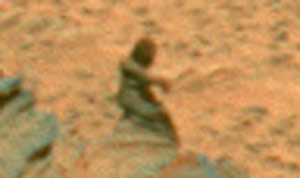[adrotate banner=”1″]It is NOT my giant, living planet finally achieving consciousness and preparing to feed on neighboring moons for the first time. I repeat, it is NOT a giant living planet I created named Gorth who will soon devour planets on my command if they do not hand over their secret advanced technology. You have nothing to fear. Go back to watching American Idol. Remember to vote for the worst!
PS: Also ignore the Bloop in the ocean. Just don’t go swimming after dark if you hear it.
Mystery Roar from Faraway Space Detected
Andrea Thompson
Senior Writer
SPACE.com andrea Thompson
senior Writer
space.com – Wed Jan 7, 10:31 pm ETLONG BEACH, Calif. — Space is typically thought of as a very quiet place. But one team of astronomers has found a strange cosmic noise that booms six times louder than expected.
The roar is from the distant cosmos. Nobody knows what causes it.
Of course, sound waves can’t travel in a vacuum (which is what most of space is), or at least they can’t very efficiently. But radio waves can.
Radio waves are not sound waves, but they are still electromagnetic waves, situated on the low-frequency end of the light spectrum.
Many objects in the universe, including stars and quasars, emit radio waves. Even our home galaxy, the Milky Way, emits a static hiss (first detected in 1931 by physicist Karl Jansky). Other galaxies also send out a background radio hiss.
But the newly detected signal, described here today at the 213th meeting of the American Astronomical Society, is far louder than astronomers expected.
There is “something new and interesting going on in the universe,” said Alan Kogut of NASA’s Goddard Space Flight Center in Greenbelt, Md.
A team led by Kogut detected the signal with a balloon-borne instrument named ARCADE (Absolute Radiometer for Cosmology, Astrophysics, and Diffuse Emission).
In July 2006, the instrument was launched from NASA’s Columbia Scientific Balloon Facility in Palestine, Texas, and reached an altitude of about 120,000 feet (36,500 meters), where the atmosphere thins into the vacuum of space.
ARCADE’s mission was to search the sky for faint signs of heat from the first generation of stars, but instead they heard a roar from the distant reaches of the universe.
“The universe really threw us a curve,” Kogut said. “Instead of the faint signal we hoped to find, here was this booming noise six times louder than anyone had predicted.”
Detailed analysis of the signal ruled out primordial stars or any known radio sources, including gas in the outermost halo of our own galaxy.
Other radio galaxies also can’t account for the noise – there just aren’t enough of them.
“You’d have to pack them into the universe like sardines,” said study team member Dale Fixsen of the University of Maryland. “There wouldn’t be any space left between one galaxy and the next.”
The signal is measured to be six times brighter than the combined emission of all known radio sources in the universe.
For now, the origin of the signal remains a mystery.
“We really don’t know what it is,”said team member Michael Seiffert of NASA’s Jet Propulsion Laboratory in Pasadena, Calif.
And not only has it presented astronomers with a new puzzle, it is obscuring the sought-for signal from the earliest stars. But the cosmic static may itself provide important clues to the development of galaxies when the universe was much younger, less than half its present age. Because the radio waves come from far away, traveling at the speed of light, they therefore represent an earlier time in the universe.
“This is what makes science so exciting,” Seiffert said. “You start out on a path to measure something – in this case, the heat from the very first stars – but run into something else entirely, some unexplained.”


